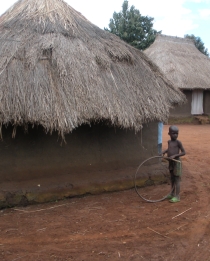In his popular book Peace Child, Don Richardson describes his experiences with the Sawi people of Papua New Guinea. At the time, this group was constantly at war with two neighboring tribes. When Don and his family decided they would need to leave because of the constant warring, the Sawi people and their enemy tribes came together to make peace.
 The Richardson family then watched as members of the Sawi tribe exchanged their young children with the neighboring villages. As long as the tribes welcomed the other tribes’ children and cared for them as their own, the tribes would be at peace with each other. Don and his family were stunned by how parallel this ritual was to the way that God gave his only son to mankind in a sense, so that we could have peace with God.
The Richardson family then watched as members of the Sawi tribe exchanged their young children with the neighboring villages. As long as the tribes welcomed the other tribes’ children and cared for them as their own, the tribes would be at peace with each other. Don and his family were stunned by how parallel this ritual was to the way that God gave his only son to mankind in a sense, so that we could have peace with God.
The term “redemptive analogy,” popularized by Richardson’s book, is used within the study of Christian missions to refer to a practice or belief native to any given culture that distinctly parallels or illustrates the gospel. It might amaze you to know how often these redemptive analogies surface in cultures all over the world. When they present themselves, they stand as natural bridges for communicating the full depth of the story of the Bible or one key aspect of it, in terms that really penetrate the heart.
While I was working as an intern with Pioneer Bible Translators in the summer of 2011, one of our directors shared a redemptive analogy that she came across while facilitating a Trauma Healing seminar in northern Africa. She was working with a people group that had been consumed by animosity for a neighboring group due to conflicts over livestock, crops, etc. She asked if there was any way that peace could be achieved with this other faction. After some discussion and thinking, the people remembered an old rite that they could perform with the other tribe.
In this ritual, the two enemy tribes would meet on the opposite banks of a river with a goat for sacrifice.

The two groups would wade into the river, slit the goat’s throat, plunge it underwater, and bathe in the river as the goat’s blood washed over them in the current. After washing in the river and the blood of the sacrifice, the two tribes would come out of the river, both on the same side. When they left the river after the ritual, the two tribes would be one family and, since one cannot kill his own family, the warring would cease forever.
Listening to our director recount this to us, we were stunned by how amazingly parallel this was to God’s own work of making peace with and for us. The story of the Bible is that we were in a war of our own making with God. We could have no peace until God provided the sacrifice – his own son, his own self – and met us in the river. When we meet Him in the river and wash in the blood of the sacrifice, we can exit with God as his family and we have an everlasting peace with God.
As amazing as this story was to me, it really hit home when we realized that our team was currently working on typing up the books of John and Acts in the language of this exact people group. We were working to continue the work of putting this story in their hands and in their hearts.
While working with the Scriptures in the languages of multiple peoples across Africa, I was stirred by the truth that God speaks every language. He knows and understands the whispers and groanings of hearts. His message is for our whole selves, and it is the message of a God who drew near, who made the ultimate sacrifice to make peace with we who beat Him back with bloodied hands.
I hope this true story was as meaningful for you as it was for me, and I pray God will increasingly give us eyes to see redemptive analogies both in our own culture, and in those that seem worlds apart from ours. Just as Don Richardson saw that ritual as a means of anchoring the gospel in the world of the Sawi, in images and experiences that resonate with them, so we can keep our eyes and ears open for redemptive analogies in our own communities and families, being diligent and intentional to communicate the gospel not just in the vocabulary and grammar of the people around us, but in words and images that speak to their hearts.


One thought on “The Power of a Redemptive Analogy”